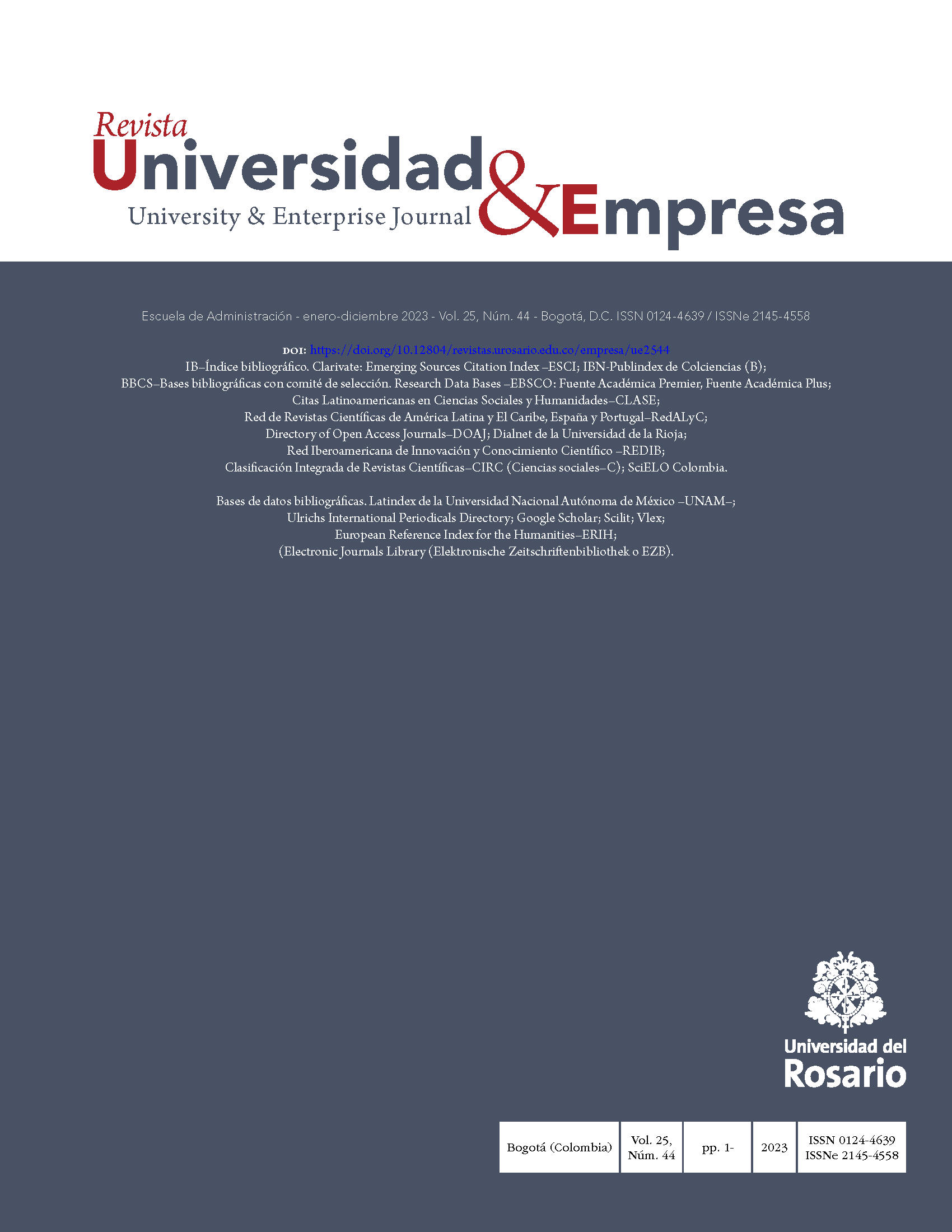Servitización en la práctica: investigación sobre la transición de modelos de negocio centrados en productos a modelos centrados en servicios en empresas manufactureras
Barra lateral del artículo
Contenido principal del artículo
La Servitización o infusión de servicios en la propuestas de valor, se ha convertido en una estrategia competitiva que ha transformado los modelos de negocio en todo el mundo. Esta investigación surge por la necesidad de describir el proceso de implementación de la servitización en el Área Metropolitana del Valle de Aburrá, para lo cual se usó una metodología cualitativa por medio de entrevistas, a 12 directivos de empresas manufactureras con tipología de cliente B2B y a un experto en modelos de negocios de servicios. Los hallazgos revelaron que las empresas se acercan a la servitización por razones similares, aunque hay disparidad en la implementación. También se evidencian los retos empresariales que este modelo acarrea.
Descargas
Baines, T., & Lightfoot, H. (2013). How manufacturers can compete through Servitization and product service system. John Wiley & Sons.
Basco, A. I., De Azevedo, B., Harraca, M., & Kersner, S. (2020). América latina en movimiento: competencias y habilidades en la cuarta revolución industrial [Nota Técnica No idbtn-1844]. bid; intal; int. http://dx.doi.org/10.18235/0002132
Corbin, J., & Strauss, A. (2002). Bases de la investigación cualitativa. Universidad de Antioquia
De la Calle, A., & Freije, I. (2016, primer trimestre). ¿Es la servitización tan rentable como puede parecer? Evidencias de empresas manufactureras españolas durante dos décadas. UCJC Business and Society Review (Universia Business Review), (49). https://journals.ucjc.
edu/ubr/article/view/1717
Grönroos, C. (1995). Relationship marketing: the strategy continuum. Journal of the academy
of marketing science, 23(4), 252-254. https://doi.org/10.1007/BF02893863
Grönroos, C. (2006). Adopting a service logic for marketing. Marketing Theory, 6(3), 317-333. https://doi.org/10.1177/1470593106066794
Grönroos, C., & Gummerus, J. (2014). The service revolution and its marketing implications:
service logic vs service-dominant logic. Managing service quality: An International Journal, 24(3), 206-229. https://doi.org/10.1108/MSQ-03-2014-0042
Guber, R. (2001). La Etnografía. Método, campo y reflexividad. Norma. https://antroporecursos.files.wordpress.com/2009/03/guber-r-2001-la-etnografia.pdf
Gummerus, J., & von Koskull, C. (Eds.). (2015). THE NORDIC SCHOOL-Service Marketing and
Management for the Future. cers, hanken School of Economics. https://helda.helsinki.fi/bitstream/handle/10138/156531/The%20Nordic%20School%20-%20Service%20Marketing%20and%20Management%20for%20%20the%20Future.pdf?sequence=1
Gummesson, E. (1991). Marketing-orientation Revisited: The Crucial Role of the Part-time Marketer. European Journal of Marketing, 25(2), 60-75. https://doi.org/10.1108/03090569110139166
Hernández, R., Fernández, C., & Baptista, M. (2014). Metodología de la Investigación (6ª ed.).
McGraw-Hill Education.
Kamp, B., & Gil de San Vicente, I. (2021). La dimensión financiera como condicionante de la
servitización y los servicios avanzados. Economía industrial, (422), 69-80.
Kohtamäki, M., Baines, T., Rabetino, R., & Bigdeli, A. Z. (Eds.). (2018). Practices and Tools for Servitization. Palgrave Macmillan. https://doi.org/10.1007/978-3-319-76517-4
Kowalkowski, C., & Ulaga, W. (2017). Service Strategy in action: A practical guide for growing
your b2b service and solution business. Service strategy press.
Kowalkowski, C., Gebauer, H., Kamp, B., & Parry, G. (2017, enero). Servitization and deservitization: Overview, concepts, and definitions. Industrial Marketing Management, 60,
-10. https://doi.org/10.1016/j.indmarman.2016.12.007
Levitt, T. (1960). Marketing myopia. Harvard business review, 38(4), 24-47.
Lince Prada, M. F., & Rave Herrera, B. H. (Coords.). (2010). Atlas. Área Metropolitana del Valle de Aburrá (1a ed.). https://www.metropol.gov.co/planeacion/Documents/Atlas_Metropolitano.pdf
Mason, J. (2002). Qualitative Researching. sage.
Mastrogiacomo, L., Barravecchia, F., & Franceschini, F. (2019). A worldwide survey on manufacturing servitization. International Journal of Advanced Manufacturing Technology, 103, 3927–3942. https://doi.org/10.1007/s00170-019-03740-z
Mejía Navarrete, J. (2000). El muestreo en la investigación cualitativa. Investigaciones sociales,
(5), 165-180. https://doi.org/10.15381/is.v4i5.6851
Ministerio de Comercio, Industria y Turismo. (2019, 6 de junio). Gobierno expide nueva clasificación de empresas. https://www.mincit.gov.co/prensa/noticias/industria/gobierno-expide-nueva-clasificacion-de-empresas-a
Neely, A. (2007, 17-19 de junio). The Servitization of Manufacturing: An Analysis of Global
Trends. 14th European Operations Management Association Conference. Bilkent University,
Ankara, Turkey. https://www.researchgate.net/publication/237137711_The_servitization_
of_manufacturing_an_analysis_of_Global_Trends
Rabetino, R., Kohtamäki, M., & Gebauer, H. (2017, octubre). Strategy map of servitization.
International Journal of Production Economics, 192, 144-156. https://doi.org/10.1016/j.ijpe.2016.11.004
Raddats, C., Kowalkowski, C., Benedettini, O., Burton, J., & Gebauer, H. (2019, noviembre). Servitization: A contemporary thematic review of four major research streams. Industrial Marketing Management, 83, 207-223. https://doi.org/10.1016/j.indmarman.2019.03.015
Schmenner, R. W. (2009). Manufacturing, service, and their integration: some history and
theory. International Journal of Operations & Production Management, 29(5), 431-443. https://doi.org/10.1108/01443570910953577
Spiggle, S. (1994, diciembre). Analysis and Interpretation of Qualitative Data in Consumer Research. Journal of Consumer Research, 21(3), 491-503. https://doi.org/10.1086/209413
Shostack, G. L. (1977). Breaking free from product marketing. Journal of marketing, 41(2), 73-80. https://doi.org/10.1177/002224297704100219
Szász, L., & Seer, L. (2018). Towards an operations strategy model of servitization: the role of sustainability pressure. Operations Management Research, 11(1), 51-66. https://doi.org/10.1007/s12063-018-0132-0
Vandermerwe, S., & Rada, J. (1988, invierno). Servitization of business: Adding value by adding
services. European Management Journal, 6(4), 314-324. https://doi.org/10.1016/0263-2373(88)90033-3
Vargo, S. L., & Lusch, R. F. (2004). Evolving to a new dominant logic for marketing. Journal of Marketing, 68(1), 1-17. https://doi.org/10.1509/jmkg.68.1.1.24036
Vargo, S. L., & Lusch, R. F. (2006). The Service Dominant Logic: Dialog, debate, and directions.
New York: Cambridge.
Witell, L., & Löfgren, M. (2013). From service for free to service for fee: business model innovation in manufacturing firms. Journal of Service Management, 24(5). https://doi.org/10.1108/JOSM-04-2013-0103
Detalles del artículo

Esta obra está bajo una licencia internacional Creative Commons Atribución-NoComercial 4.0.
Los autores conservan los derechos de autor y garantizan a la revista el derecho de ser la primera publicación del trabajo al igual que licenciado bajo una Creative Commons Attribution License que permite a otros compartir el trabajo con un reconocimiento de la autoría del trabajo y la publicación inicial en esta revista.Artículos más leídos del mismo autor/a
- Simón Tamayo-Buitrago, María Claudia Mejía-Gil, Lina M. Ceballos, Exploración de las experiencias memorables y la fidelización en las ventas por catálogo , Revista Universidad y Empresa: Vol. 23 Núm. 40 (2021)




